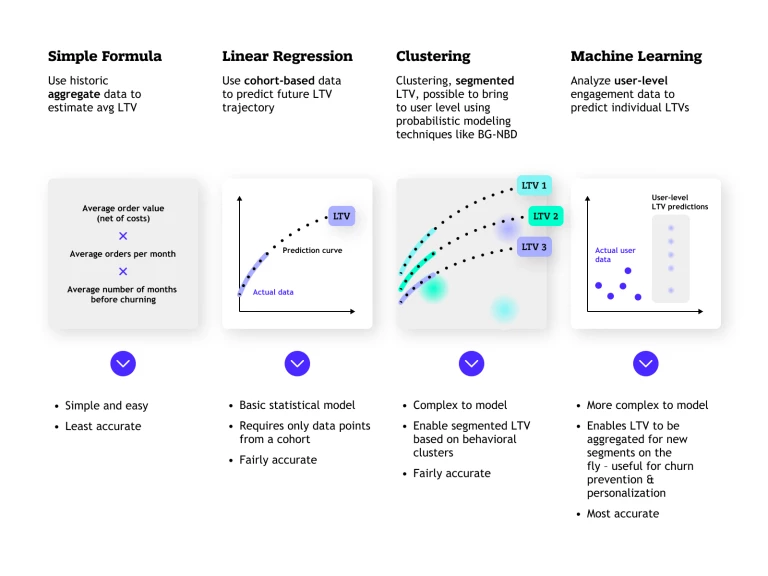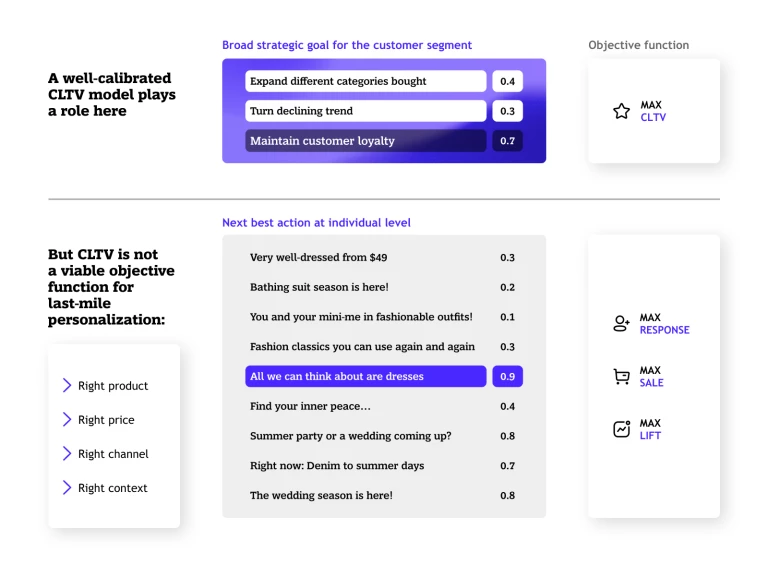Marketing is no stranger to having to do more with less, especially in today’s economic climate. But even during periods of growth, businesses need to carefully allocate their marketing dollars. Exploring experimental frameworks for traditional marketing strategies is one way marketers can drive efficiencies and, at the same time, improve marketing performance.
Customer lifetime value (CLV or CLTV) is to marketing strategy what price elasticities are to pricing strategy: an analytically robust crutch that can inform your marketing strategies. But marketers must understand its inherent assumptions — and limitations.
CLV is hardly a new framing and considers the forward-looking value of your customers, not their present value. And while advances in data science might not have brought material improvements to its calculation, they have changed our ability to personalize decisions.
CLV is not the whole story
Many conversations in my advisory role at
BCG X
, the tech build and design unit of BCG, revolve around CLV. Questions I commonly hear include:
- How can I improve CLV to inform product recommendations?
- How do I optimize incentives with CLV as an objective function?
- How can I make CLV the key driver of personalized journeys?
The short answer to these questions: You can’t.
While the intuition that we need to de-average and personalize our outreach based on customer value is sound, it also assumes our information is perfect. Not only that, but this information also needs to be conditional, meaning it needs to predict the future conditional to a specific treatment—or the lack of treatment.
Suppose I can predict that Lucia will spend $50 per month at an investment of $5 marketing dollars (the treatment) but will only spend $40 without any incentive spend (no treatment). In that case, I know I’m getting a positive return on that marketing incentive budget. Extrapolate this process to a broad range of marketing decisions at an individual level, and you’ve created a failproof marketing ROI maximizer.
This is the ideal version of CLV: the perfect prediction of future spending, conditional to a treatment, for each customer. But—data science chops notwithstanding—we don’t have the level of detail we need to arrive at that, so there’s no point overcomplicating CLV calculations.
Simplifying CLV formulations
Here is a comprehensive formula for calculating CLV:

The logic is similar to a discounted cash flow, instead applied to future individual purchases. Your refinements should be industry-specific, but here are a few of the most common trade-offs:
- Forecast full currency (simpler) or margin (harder)
- Discount as is, or by applying a cost of capital
- Apply a simple heuristic to “customer life” or more complex data science approaches (e.g., a survival model)
- Apply a simple curve to sales volume (typically decreasing over time) or a more nuanced, lumpy prediction that is adjusted for inflation
With increased sophistication analysts can move from big averages to Machine Learning-based individualized predictions, then aggregated back to the full population.

It’s possible to validate CLV accuracy by backtesting—the process of applying the formula to historical periods and comparing the predicted versus actual results. The smaller the error, the better the formula. Broadly speaking, backtesting shows that over-engineering a CLV calculation offers rapidly diminishing returns. However, the most significant drawbacks are around conditionality and sensitivity.
Why conditionality and sensitivity matter
For CLV, the biggest hurdles have to do with conditionality (the ability to predict the future in various treatment scenarios) and sensitivity (the ability to rapidly adjust to a change in conditions). Here’s why:
- Conditionality is a big average, so it doesn’t change based on our assumptions of marketing intensity.
- Sensitivity doesn’t move much between purchases since CLV’s top explanatory variable is (intuitively) the last transaction. We tend to see that sensitivity stays flat before spiking up when the next purchase is completed.
Putting conditionality and sensitivity aside, CLV is still uniquely positioned to inform whether marketing is not only performing, but also driving incremental value. Let’s say we select a customer cohort, introduce new marketing approaches, and measure the change in CLV over time. If that cohort performs better by showing a higher CLV value, we have an analytical confirmation that our marketing strategies work. That is of considerable strategic value.
Even though CLV doesn’t move fast enough on an individual level, it does reflect with high fidelity the behavior changes of a large group. For that reason alone, it’s worth the time and effort.
As to CLV limitations, marketers have many other levers to drive day-to-day decisions with conditionality and sensitivity in mind. I recommend:
- Engagement scores based on browsing, product usage, or general interest outside of transactions
- Propensity modeling for product recommendations
- Synthetic scores for offer propensity and incentive elasticity
- Lift modeling for conditional assessment of next-best-action
- Channel and language preferences for tailored outreach
- Any form of real-time suppression based on inventory levels or availability
Any segmented marketing tactic can become highly individualized using these and other levers. And once we add the right product, incentive, language, and channel—this segment-level decision becomes hyper-personalized.
Melding CLV and personalization
CLV and personalization represent the gradient from strategic to tactical decisions. Although there are numerous personalization options (all the permutations of timing, sequence, language, and more), the key lies in simplification.
There are many sound approaches, but my preferred one is a four-step process that combines traditional, strategic CLV activities with tactical implementations of personalized decisions:
Strategic Decisions
- Break down the lifecycle into typical phases, such as onboarding, retention, and reactivation.
- Define marketing tactics for each phase. Onboarding can focus on education and information; reactivation may focus on catchy language and delight nudges; and re-engagement may rely on surprise and delight offers and behavioral nudges to incent disengaged customers to re-visit the store.
Tactical Decisions
- Populate the marketing tactics defined at the segment or lifecycle level with highly personalized configurations: the same cohort receives a cross-sell offer, but each individual sees their relevant product, call-to-action, and incentive.
- Once individual tactics have been personalized, harness proper experimental design, reinforcement learning, and causal inference to optimize the sequence of tactics that work best for your business. Alternatively, rule-based tactics can also be applied at this stage.
In summary, CLV drives strategic decisions at the segment/cohort level, while machine learning (ML) and experimentation drive tactical decisions at an individual level. That’s because CLV doesn’t move fast enough to track customer decisions that could theoretically change every hour, but ML and experimentation can.
The key is to find the right balance between your strategic and tactical steps. I recommend that only 20% of short-term effort be allocated to CLV, while the remaining 80% be dedicated to tactical actions.

How this process might look
Let’s look at a “cold start” scenario, at time zero and with no prior experiments to revert to. At this point, I advise marketers to segment and pair tactics based on intuition and business logic. Subject matter expertise and industry specificity go a long way, and CLV can still be helpful in de-averaging tactics for high-value versus low-value customers.
Beyond this “cold start” moment, the groundbreaking application is showing how strategic marketing decisions drive meaningful, positive change in CLV at the cohort level. Using controlled trials, data-driven marketers can test whether their choice of tactical steps is correct by asking questions like:
- Does it make sense to onboard and then cross-sell?
- Is nine months the proper definition for churn?
- How rich should a surprise and delight offer be?
Change in CLV is the ultimate litmus test for broader marketing strategies — but the complication here is a lack of velocity. Even the most sophisticated CLV formulas don’t move every week — and can’t reflect granular tactical changes.
To account for this, businesses need to add two, separate testing strategies to cover:
- High-level, strategic decisions that require time to measure but don’t change too often
- Parameter refinement at a tactical level (the typical fine-tuning of product, language, channel, intensity, and so on)
Bringing together strategic and tactical decisions
Don’t assume that the scientific, real-time application of CLV moves the needle. As we discovered, CLV alone can’t help inform product recommendations, optimize incentives, or drive customer journeys.
Data-driven marketers have a whole arsenal of analytical solutions at their fingertips. CLV is just one of them, which means a simple, intuitive formula is all you need.
The real power comes when you add the tactical, experimental framework for measuring CLV changes over time. These changes can then be used to inform, corroborate, or suppress your marketing strategies.
The more complex these tactical experimentation steps are, the easier it is to uncover the benefits of continuously optimized journeys—rather than focusing solely on the performance of individual campaigns. And that’s where the real magic lies.